
The Bashkirs or Bashkorts are a Kipchak Turkic ethnic group indigenous to Russia. They are concentrated in Bashkortostan, a republic of the Russian Federation and in the broader historical region of Badzhgard, which spans both sides of the Ural Mountains, where Eastern Europe meets North Asia. Smaller communities of Bashkirs also live in the Republic of Tatarstan, the oblasts of Perm Krai, Chelyabinsk, Orenburg, Tyumen, Sverdlovsk and Kurgan and other regions in Russia; sizable minorities exist in Kazakhstan and Uzbekistan.
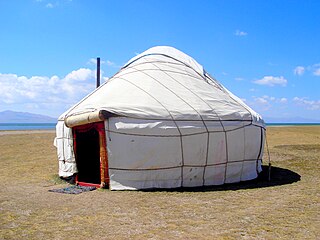
A yurt or ger (Mongolian) is a portable, round tent covered and insulated with skins or felt and traditionally used as a dwelling by several distinct nomadic groups in the steppes and mountains of Inner Asia. The structure consists of a flexible angled assembly or latticework of wood or bamboo for walls, a door frame, ribs, and a wheel possibly steam-bent as a roof. The roof structure is sometimes self-supporting, but large yurts may have interior posts supporting the crown. The top of the wall of self-supporting yurts is prevented from spreading by means of a tension band which opposes the force of the roof ribs. Yurts take between 30 minutes and 3 hours to set up or take down, and are generally used by between five and 15 people. Nomadic farming with yurts as housing has been the primary life style in Central Asia, particularly Mongolia, for thousands of years.

The flag of Kazakhstan or Kazakh flag was adopted on 4 June 1992, replacing the flag of the Kazakh Soviet Socialist Republic. The flag was designed by Shaken Niyazbekov.

Nogai also known as Noğay, Noghay, Nogay, or Nogai Tatar, is a Turkic language spoken in Southeastern European Russia, Kazakhstan, Uzbekistan, Ukraine, Bulgaria, Romania and Turkey. It is the ancestral language of the Nogais. As a member of the Kipchak branch, it is closely related to Kazakh, Karakalpak and Crimean Tatar. In 2014 the first Nogai novel was published, written in the Latin alphabet.
Od iyesi is the Turkic and Mongolian spirit or deity of fire. In Turkic languages, Od means fire, and iye is the familiar spirit of any natural asset, literally meaning "master" or "possessor." Od iyesi protects the fire.

A tubeteika is a Russian word for many varieties of traditional Central Asian caps. Tubeteikas are today worn in Tajikistan, Kazakhstan, Kyrgyzstan, and Uzbekistan, as well as in Muslim-populated regions of Russia and Azerbaijan. The skullcap worn by Uzbeks and Uyghurs is called a doppa and has a square base. It was a popular headgear among children throughout the USSR during the 1940s and 1950s.

Turkic mythology refers to myths and legends told by the Turkic people. It features Tengrist and Shamanist strata of belief along with many other social and cultural constructs related to the nomadic and warrior way of life of Turkic and Mongol peoples in ancient times. Turkic mythology shares numerous points in common with Mongol mythology. Turkic mythology has also been influenced by other local Asiatic and Eurasian mythologies. For example, in Tatar mythology elements of Finnic and Indo-European mythologies co-exist. Beings from Tatar mythology include Äbädä, Alara, Şüräle, Şekä, Pitsen, Tulpar, and Zilant.
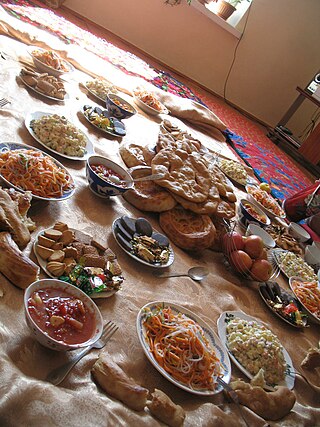
Central Asian cuisine has been influenced by Persian, Indian, Arab, Turkish, Chinese, Mongol, African, and Russian cultures, as well as the culinary traditions of other varied nomadic and sedentary civilizations. Contributing to the culinary diversity were the migrations of Uyghur, Slav, Korean, Tatar, Dungan and German people to the region.
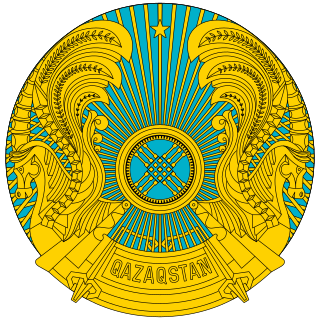
The emblem of Kazakhstan was adopted on June 4, 1992. The designers of the emblem are Jandarbek Melibekov and Shot-Aman Ualikhan About 245 projects and 67 description designs of the future arms took part in the final competition. Like other post-Soviet republics whose symbols do not predate the October Revolution, the current emblem retains some components of the Soviet one, in this case, rising sun rays and star. Prior to 1992, Kazakhstan had an emblem similar to all other Soviet Republics.

The Lyuli, Jughi or Jugi are a branch of the Ghorbati people living in Central Asia, primarily Tajikistan, Uzbekistan, Turkmenistan, Kazakhstan, and southern Kyrgyzstan; also, related groups can be found in Turkey, and the Balkans, Crimea, Southern Russia and Afghanistan. They speak ethnolects of the Persian and Turkic language and practice Sunni Islam. The terms Lyuli and Jugi are considered pejorative. They have a clan organization. Division into sub-clans is also practiced. The Lyuli community is extremely closed towards non-Lyuli.

The kobyz or kylkobyz, or qobyz, is an ancient Turkic bowed string instrument, spread among Kazakhs, Karakalpaks, Bashkirs, and Tatars. The Kyrgyz variant is called the kyl-kyyak).
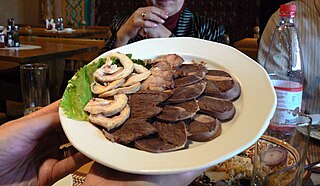
Qazı is a traditional sausage-like food of Kazakhs, Tatars, Kyrgyz, Uzbeks and other Turkic or Central Asian ethnic groups. It is a common element on a dastarkhan, a table set for a festive meal. A reviewer from VICE Magazine described the dish as smoky and earthy. Horse meat is usually used for Qazı.
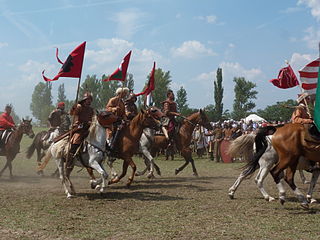
The Great Kurultáj or briefly Kurultáj is a traditional event of peoples of Central Asian nomadic origins, which takes place in the first week of August in Bugac, Hungary. The aim of this event is to strengthen the unity of the Eurasian steppe-nomadic horse culture and traditions between Hungarians and their cultural relatives, eastern Turkic peoples and Altaic peoples. The first Kurultáj was held in the Torgay Region of Kazakhstan in 2007. The first Kurultáj in Hungary was held in 2008. These events contributed much to the revival of the Altaic self-awareness.

Tulpar is a Turkish heavy infantry fighting vehicle designed by the Sakarya-based automotive manufacturer Otokar. It is named after the Tulpar, a winged horse in Turkic mythology.
Abakhan is a legendary khan (king) in Turkic mythology. He is also known as Aba Khan, Abakan or Abahan, and is considered to be the ancestor of the Khakass and Abakan peoples.
Yel iyesi is the Turkic spirit or deity of wind. The name comes from the Turkic words "Yel," which means wind, and "iye," the familiar spirit of any natural asset.
Szélanya is the Hungarian goddess or deity of wind.
Szélatya or Szélkirály is the Hungarian god or deity of wind.
Yer iyesi is the spirit or deity of earth or territory in Tengrism. In Turkic languages Yer means land or earth. And İye is the familiar spirit of any natural asset. Yer iyesi protects the earth or any region. Also known as Toprak iyesi.















